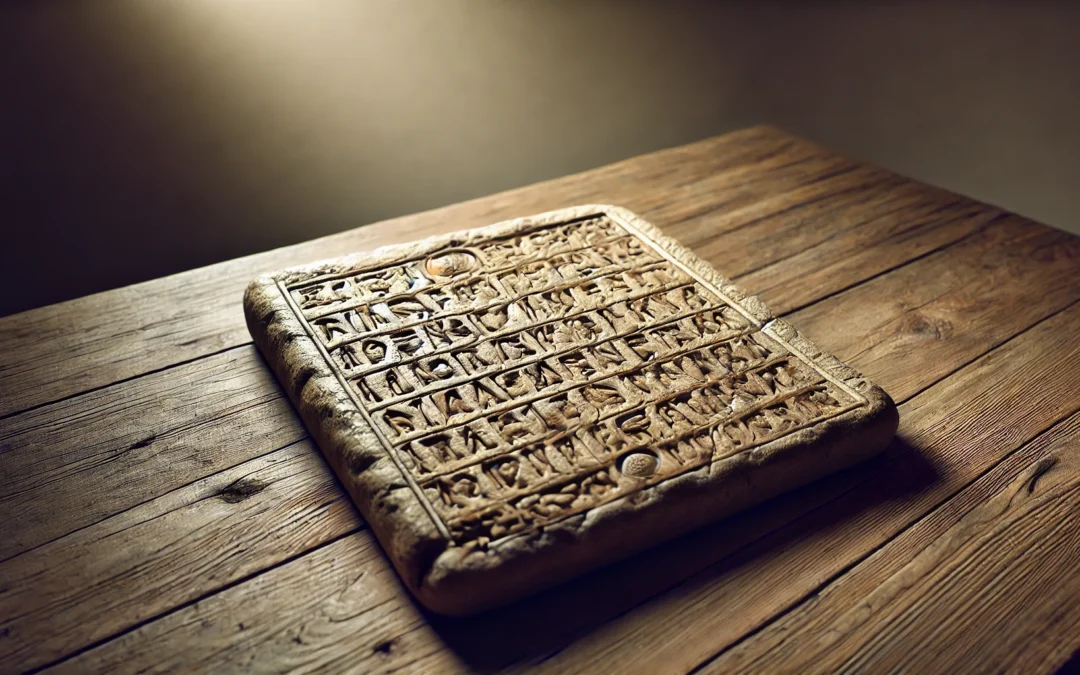Have you ever picked up a classic novel or watched an old movie and stumbled upon a word or phrase that seemed a bit out of place? That’s because language is always evolving, and what once was common can become quite rare. These outdated words and expressions are known as archaisms. They give us a fascinating glimpse into how people used to speak and write. While they might sound unusual today, they were once part of everyday conversations.
Archaisms can be found in literature, historical documents, and even in some family traditions. Think about the word “thou” or the phrase “forsooth.” These terms might spark a memory or even a chuckle, as they remind us of Shakespearean plays or old folktales. By exploring these archaisms, we can appreciate the richness of language and how it reflects changes in culture and society. In this article, we’ll look at 20 intriguing examples of archaisms that have fallen out of regular use but still hold a special charm.
What is Archaism?
Archaism refers to the use of words, phrases, or stylistic elements that are considered outdated or old-fashioned. These linguistic elements are typically derived from an earlier period in history and are no longer in common use in the modern language. Archaisms are often employed in literature, poetry, and formal speeches to evoke a sense of antiquity, tradition, or historical context. They can also be used to create a particular tone or atmosphere, such as in fantasy novels or historical dramas, where the language of a bygone era enhances the setting and immersion.
In writing, archaisms can serve multiple purposes. They can lend an air of authenticity to historical fiction, helping readers to feel transported to the time period being depicted. In poetry, they might be used to adhere to a traditional form or to evoke the style of a revered poet from the past. Moreover, archaisms can also be used humorously or ironically to highlight the contrast between past and present language usage.
It is important to note that while archaisms can enrich a text by adding depth and historical flavor, overuse can render the writing difficult to understand for contemporary readers. Therefore, writers often use them sparingly to maintain clarity while achieving the desired effect.
Key Examples of Archaism
Archaisms appear in many forms, from single words to entire phrases that once shaped daily speech. Below, you’ll find 20 intriguing examples that showcase how these elements of language continue to spark curiosity and nostalgia.
1. Thou and Thee in Modern Writing
In some contemporary poetry, you might find the words “thou” and “thee.” These words are archaic forms of “you.” Writers use them to create a sense of antiquity or to evoke the style of older texts. This choice helps set the tone and atmosphere, transporting readers to a different time.
2. The Use of “Ye Olde” in Shop Names
Many businesses use “Ye Olde” in their names to give a sense of tradition or nostalgia. The phrase “Ye Olde” is a deliberate archaism, mimicking the style of Middle English. It provides a quaint, old-fashioned feel, often used to attract customers looking for authenticity or charm.
3. Shakespearean Language in Plays
Shakespeare’s works are full of archaic language, such as “hath” for “has” and “doth” for “does.” When modern playwrights or directors use this language, they are embracing archaism. It helps audiences connect with the historical context and appreciate the original flavor of the text.
4. Legal Terms in Courtrooms
Legal language often includes archaic words like “herein” and “aforementioned.” These terms are remnants of older English used in legal contexts to maintain consistency and precision. While they may seem outdated, they lend a sense of formality and continuity to legal proceedings.
5. Religious Texts and Sermons
Many religious texts retain archaic language, such as “verily” and “thou shalt.” This language is often used in sermons to preserve the original tone and authority of traditional scriptures. It connects believers to their faith’s history and roots.
6. Historical Novels and Films
Writers and filmmakers often use archaic language to enhance the authenticity of historical settings. Words like “forsooth” or “anon” might appear in dialogue to give characters a believable voice from the past. This usage helps immerse audiences in the story’s time period.
7. Epic Poems and Ballads
Epic poems and ballads often feature archaic language to capture the grandeur and gravity of their stories. Terms like “ere” for “before” or “whilst” for “while” can be found in these works. They add a timeless quality that connects readers to the tradition of oral storytelling.
8. Fantasy Literature
In fantasy novels, archaic language is frequently employed to create a sense of otherworldliness. Authors might use “henceforth” or “thrice” to lend an ancient or mystical feel to their narratives. This approach helps build a distinct and immersive world for readers.
9. Folk Songs and Traditional Music
Folk songs often preserve archaic language, passing it down through generations. Words like “farewell” and “merry” are used to maintain the song’s original charm and authenticity. This language connects listeners to cultural heritage and history.
10. Renaissance Fairs and Reenactments
At Renaissance fairs, participants often speak using archaic words and phrases. Terms like “prithee” for “please” or “huzzah” for “hooray” are common. This use of archaism helps recreate the atmosphere of the past and enriches the overall experience for visitors.
11. Traditional Wedding Vows
In many wedding ceremonies, couples choose to use traditional vows that contain archaic language. Phrases such as “to have and to hold” or “till death do us part” have origins in older English. These expressions lend a sense of solemnity and continuity, linking the present-day ceremony with centuries of matrimonial tradition.
12. Proverbs and Sayings
Old proverbs often contain archaic words or structures that have persisted through time. “A stitch in time saves nine” or “a penny saved is a penny earned” use language that evokes a bygone era. These timeless sayings, despite their linguistic age, remain relevant, offering wisdom that transcends generations.
13. Historical Speeches and Documents
When studying historical speeches, one might encounter archaic language that captures the essence of the period. Phrases like “four score and seven years ago” from Abraham Lincoln’s Gettysburg Address give a glimpse into the past. Such language provides a window into the historical mindset and societal values of the time.
14. Heraldic Mottoes
Family crests and heraldic mottoes often feature archaic terms that have been preserved over centuries. Words like “fortis” or “virtus” hark back to Latin and Old French origins, reflecting the noble lineage and values of a family. These mottoes serve as a bridge between the past and present, maintaining a family’s heritage.
15. Classical Literature Studies
In academic settings, students may encounter archaic language when studying classical literature. Texts by authors like Chaucer or Milton include words and phrases that are no longer in common use. Understanding these terms is crucial for appreciating the linguistic richness and historical context of the works.
16. Antique Recipe Books
Old cookbooks often contain recipes written in archaic language, with measurements like “gill” or instructions such as “stew until done.” These books offer a snapshot of historical culinary practices and vocabulary. They provide insight into how cooking and language have evolved over time.
17. Antiquarian Bookstores
Antiquarian bookstores sometimes use archaic language in their advertising or signage to evoke a sense of history and tradition. Phrases like “rare tomes” or “volumes of yore” attract bibliophiles interested in the charm of past literature. This language emphasizes the unique and timeless nature of the books they offer.
18. Genealogical Records
Genealogical research often involves examining documents with archaic terms and phrasing. Birth, marriage, and death records from centuries ago may use language that is unfamiliar to modern readers. Understanding these terms is essential for accurately tracing family histories and appreciating ancestral narratives.
19. Mythological Texts
Ancient myths and legends frequently employ archaic language, lending an air of mystery and antiquity. Stories of gods and heroes might use terms like “thou” or “behold” to convey their timeless nature. This language helps preserve the original tone and grandeur of the myths as they were first told.
20. Classic Fairy Tales
Fairy tales often retain archaic elements, with phrases like “once upon a time” or “happily ever after.” These stories, handed down through generations, use language that connects readers to the past. The archaic language enhances the magical quality of the tales, making them enduring favorites for both children and adults.
Language Evolution and Its Impact on Communication
Language changes constantly, shaped by the people who use it. Words and phrases that were once common can fade away, while new ones emerge to fit modern life. This evolution isn’t just interesting – it’s a window into how societies grow and adapt.
Think about how technology has changed the way we talk. A few decades ago, words like “selfie” or “hashtag” didn’t exist. Now, they’re part of our everyday conversations. Language reflects the tools we use and the culture we live in, adapting to keep up with the world around us.
But it’s not just about new words. The way language evolves also says a lot about values and norms. For example, as societies grow more aware of different perspectives, language often becomes more inclusive. Words or phrases that once seemed fine might get replaced by ones that better suit how people think today.
You can also see this evolution in books, movies, and other creative works. Writers often mix older language with modern expressions to create something unique. This blend can make their work feel timeless, combining the weight of the past with the immediacy of the present.
Understanding how language changes helps us connect with others, both now and in the future. It shows how words are more than just tools for talking—they carry history, meaning, and emotion. And while some old words might fade, their influence remains, shaping the way we speak and write today.
Understanding Archaism in Language and Literature
Archaism refers to the use of words, phrases, or language styles that are considered outdated or old-fashioned. In literature, archaisms are often used to evoke a sense of history or tradition, providing a certain charm or authenticity to the text. Writers might use archaic language to create a specific atmosphere, such as in historical novels or fantasy stories where an ancient setting is crucial. For example, words like “thou,” “thee,” and “hast” are often used to mimic the language of the past and to give characters a more classical voice. This technique can help readers feel transported to a different time, enhancing their immersion in the story.
In poetry, archaisms can be used to maintain rhyme schemes or meter, as older words might fit more naturally into traditional poetic forms. Additionally, the use of archaisms can lend a musical quality to the text, as their sounds and rhythms might differ from modern language. However, overuse of archaisms can make a text difficult to read or understand, so writers must balance their use carefully. This deliberate choice of language can enrich a narrative, but it should serve the story rather than distract from it.
The Role of Archaism in Cultural Identity and Preservation
Archaism also plays a significant role in cultural identity and the preservation of heritage. In many cultures, traditional language forms are cherished as part of the community’s history and identity. Using archaic language in ceremonies, rituals, or cultural narratives can help keep these traditions alive, connecting present generations with their ancestors. This type of archaism is often found in religious texts, legal documents, and cultural epics, where maintaining the original language is crucial to preserving the intended meaning and significance.
Moreover, archaism can act as a tool for cultural education, allowing people to learn about their history and the evolution of their language. In some cases, languages that are no longer spoken in everyday life are preserved through written texts, offering insights into the past. For example, Latin, though no longer a vernacular language, is still used in academic, legal, and religious contexts, serving as a bridge to historical knowledge.
While some may see archaism as a barrier to understanding, it is often viewed as a valuable link to the past. It reminds us of where we come from and helps maintain a sense of continuity within a culture. As such, archaism holds an important place in the tapestry of human expression and cultural heritage.
How to Use Archaism Effectively in Writing
Incorporating archaisms into your writing can bring depth and texture to your work, but it requires careful thought. The goal is to evoke a sense of history or tradition without confusing or alienating your readers. Here are some practical tips to help you use archaic language effectively:
Understand the Context
Before using archaisms, consider the purpose of your writing. Are you creating a historical novel, a fantasy story, or a formal speech? Each genre has its own rules for tone and style. For example, in a historical setting, archaisms can make dialogue feel authentic. In a fantasy, they can add a sense of mystique. Always match your language to the context to avoid making it feel forced or out of place.
Choose Recognizable Archaisms
Stick to archaisms that are likely to be understood by modern readers. Words like “thou,” “hath,” or “wherefore” are widely recognized, even if they’re no longer used in everyday speech. Avoid obscure terms that might require your audience to pause and look them up. A touch of familiarity ensures your writing remains engaging and accessible.
Use Archaisms Sparingly
Less is more when it comes to archaic language. A few well-placed words or phrases can create the desired effect without overwhelming your readers. Overloading your text with outdated language can make it hard to read and distract from your story or message. Think of archaisms as seasoning—just enough to enhance the flavor.
Blend Old and New
Mixing archaic terms with modern language can make your writing feel fresh and balanced. For instance, you might use “thou” in a character’s dialogue but keep the surrounding narrative in contemporary prose. This approach helps maintain readability while still giving a nod to tradition or history.
Practice Consistency
If you choose to use archaisms, maintain a consistent style throughout your work. Switching between modern and old-fashioned language without a clear reason can confuse readers. For example, if a character speaks in an archaic manner, ensure they do so consistently across the text.
Test It with Readers
Before finalizing your writing, share it with someone else. A fresh perspective can help you gauge whether the archaisms feel natural and effective. If they seem confusing or unnecessary, consider revising. Writing is a collaborative process, and feedback is invaluable for refining your work.
Experiment and Have Fun
Don’t be afraid to play around with different archaic expressions. Writing is a creative endeavor, and experimenting with language can lead to surprising results. Try drafting a scene or a poem using a mix of old and new words. You might discover a unique style that resonates with your voice and your readers.
Examples of Effective Use
- In a historical novel: “Thou shalt not defy the king,” he declared, his voice as cold as the winter wind.
- In poetry: “Ere the morning breaks, let us whisper farewells under the pale moonlight.”
- In a fantasy setting: “Hark, traveler, for the forest holds secrets ye dare not awaken.”
Each example uses archaisms selectively to enhance the tone and immerse readers in the narrative.
Archaism in Modern Literature: Reviving the Past
In modern literature, archaism serves as a bridge to the past. Writers often use archaic words and phrases to evoke a sense of nostalgia or to create a specific atmosphere. This technique can make the narrative feel timeless or transport readers to a bygone era. For instance, authors of historical fiction might sprinkle their dialogue with outdated terms to enhance authenticity. It’s like adding a dash of spice to a dish – just enough to bring out the flavor without overpowering it.
However, the use of archaism must be balanced. Too much can alienate readers or make the text feel inaccessible. But when done well, it enriches the reading experience. It connects the present with the past, reminding us of the evolution of language and culture. This reminds us that some things, like the human experience, remain unchanged despite the passage of time. The use of archaism in literature is, therefore, a powerful tool for storytelling.
Archaism in Branding: Crafting a Timeless Image
Brands sometimes use archaism to create a timeless image. This strategy can make products feel classic or premium. Imagine a whiskey brand using old-fashioned language on its labels. It instantly conjures images of tradition and craftsmanship. This approach appeals to consumers who value heritage and quality. It’s particularly effective in industries like fashion, where vintage styles often make a comeback. But it’s not just about looking old-school. It’s about tapping into the emotions and memories associated with the past. For some companies, using archaism is a way to stand out in a crowded market. It gives them a unique voice and story. However, it’s crucial to ensure that the message remains clear. While archaism can add charm, it shouldn’t confuse the audience. The key is to blend the old with the new, creating a narrative that resonates with today’s consumers while honoring the past.
Read also: 20 Examples of Setbacks & Definition
The Most Popular on BitGlint

Top 100 Personal Items List
Everyone uses personal items in their daily lives, often without even thinking about them. From the moment you wake up...

30 Defiance Examples & Meaning
Defiance is something most people experience at some point in life. You feel it when you say no to something that...

Top 30 Desire Examples & Definition
Desire is a powerful force that drives much of human behavior, shaping our goals, dreams, and everyday decisions. It's...

100 Non-Digital Things List
In everyday life, there are still hundreds of objects, tools, and materials that exist completely outside the digital...

30 Examples of Attention & Definition
Have you ever noticed how a catchy tune can grab your attention, even when you're busy doing something else? It's...

60 Cultural Traditions Examples & Definition
Cultural traditions are part of daily life - whether people realize it or not. They shape what we eat, how we...

Top 30 Intimacy Examples & Meaning
Intimacy goes beyond physical touch or romantic moments. It’s about closeness, trust, and connection. In everyday...
Get Inspired with BitGlint
The Latest
40 Emotional Value Examples & Meaning
Why do some messages stick — while others are forgotten? Why do people choose one brand over another, even when the product is the same? The answer often comes down to emotional value. Emotional value is what makes a message feel human. It’s the emotional connection...

30 Teasing Examples & Definition
Teasing is a common part of human interaction. People tease in different ways, for different reasons. Sometimes it is friendly. Sometimes it can hurt feelings. Understanding what teasing means and seeing clear examples helps everyone handle these moments better....
40 Thought Experiments for Curious Minds
Some questions can’t be answered with a simple yes or no. Some problems don’t have a clear solution. That’s where thought experiments come in. They aren’t just old ideas from philosophy books. Thought experiments are tools we still use to think through problems, test...
Hermaphrodite: 20 Human Examples & Meaning
Hermaphroditism in humans is a complex and fascinating topic that raises many questions. Are there true human hermaphrodites? What do hermaphrodites look like? Can a hermaphrodite have both working male and female reproductive parts? These are common questions people...

